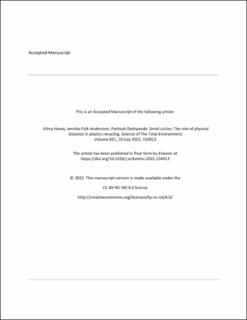| dc.contributor.author | Havas, Vilma | |
| dc.contributor.author | Falk-Andersson, Jannike | |
| dc.contributor.author | Deshpande, Paritosh | |
| dc.date.accessioned | 2022-07-13T13:35:34Z | |
| dc.date.available | 2022-07-13T13:35:34Z | |
| dc.date.created | 2022-04-01T12:49:06Z | |
| dc.date.issued | 2022 | |
| dc.identifier.citation | Science of the Total Environment. 2022, 831, 154913. | en_US |
| dc.identifier.issn | 0048-9697 | |
| dc.identifier.uri | https://hdl.handle.net/11250/3005096 | |
| dc.description | Embargo until 04.04.2024 | en_US |
| dc.description.abstract | Circular economy (CE) strategies are central in solving the waste management challenges of today, yet the global nature of the waste trade results in emissions and the export of negative environmental externalities to low-income countries. Here, we target a systemic challenge in the current indicators developed to measure more sustainable consumption and production progress. We argue that sustainable, circular solutions to recycling need to account for the negative externalities caused by the physical distance of the waste trade. We define the new concept “Small Circles” (SC) and suggest a new circularity indicator that can better ensure sustainability in implementing closed-loop strategies and thereby provide critical criteria to consider in pursuing CE. The SC approach advocates the need to manage the waste within a smaller geographical area of its origin to reduce the environmental burdens originating from the transboundary export of waste. Further, it ensures that the waste-producing regions take responsibility for their waste generation and management. If implemented appropriately, we argue that the SC approach could improve the transparency of the fate of waste and boost local opportunities through job creation and allow for the development of symbiotic relations among regional industries. The SC concept demands commitment from all stakeholders across the product value chain to extract value from the waste without jeopardizing sustainability goals. The application of the SC concept is explained by describing the sustainability challenges and opportunities related to plastic waste management in Europe. To concretize the SC approach and the circularity indicator further, the management of the plastic waste sourcing from the Norwegian fishing sector and plastic waste management in the US are used as case examples. | en_US |
| dc.language.iso | eng | en_US |
| dc.publisher | Elsevier | en_US |
| dc.rights | Attribution-NonCommercial-NoDerivatives 4.0 Internasjonal | * |
| dc.rights.uri | http://creativecommons.org/licenses/by-nc-nd/4.0/deed.no | * |
| dc.title | Small circles: The role of physical distance in plastics recycling | en_US |
| dc.type | Journal article | en_US |
| dc.description.version | acceptedVersion | en_US |
| dc.source.pagenumber | 8 | en_US |
| dc.source.volume | 831 | en_US |
| dc.source.journal | Science of the Total Environment | en_US |
| dc.identifier.doi | 10.1016/j.scitotenv.2022.154913 | |
| dc.identifier.cristin | 2014524 | |
| dc.source.articlenumber | 154913 | en_US |
| cristin.ispublished | true | |
| cristin.fulltext | postprint | |
| cristin.qualitycode | 2 | |

